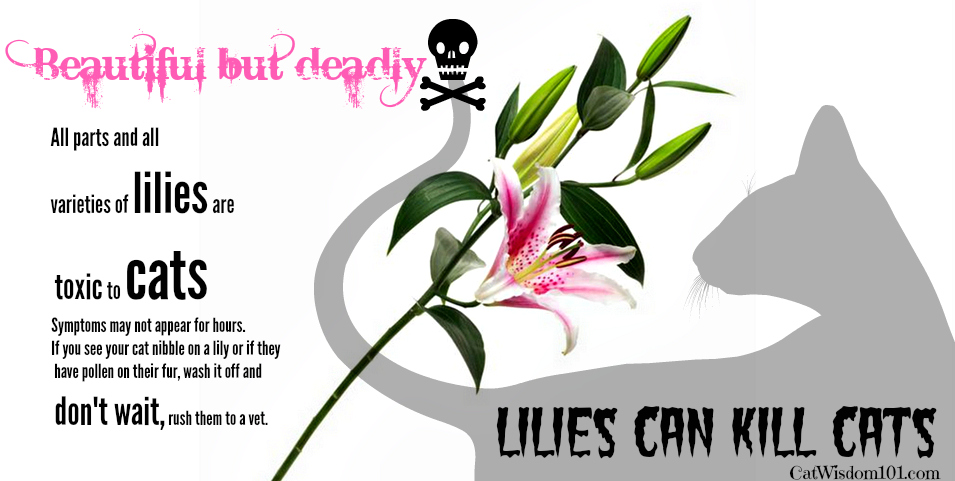
Vet 101:When Sniffs Can Kill

2018 Update by Layla Morgan Wilde. To stay safer, I recommend caution with any flowers grown from bulbs. They include the tulips, daffodils, crocuses, paper whites, hyacinth, amaryllis, cyclamen and irises but the most toxic are lilies.
Some safe choices includes, roses, carnations, daisies, sunflowers, baby’s breath, bamboo, African violets, Persian violets, zinnias, orchids, jasmine, snapdragon, pansies. There is a long list including Latin names of both toxic and safe plants from the ASPCA which needs updating. They have flowers from several lily families that should be removed. When in doubt, do more research. In over 50 years of owning cats I’ve only had one case of mild toxicity. Some cats simply aren’t nibblers. The responsibility rests with you, the cat’s owner.
With Easter around the corner, the #1 favorite flower for gifts is the lily. All lilies from pure white trumpet lilies to colorful Asiatics like Stargazers are not only toxic to cats but can be deadly. We’re re-posting a cautionary tale from a vet who saved the life of one curious cat from a killer lily. If you are shopping for flowers for yourself or as a gift, consider safer options like roses or carnations. If you receive a gift of a lilies, remove the yellow stamens (the most toxic part) and place out of reach of your cats. If that’s not possible, give it to a friend or neighbor who doesn’t have cats or donate to a hospital. Another option is to bring them if visiting a cemetery. Let’s make this holiday weekend a safe and happy one for all members of our family.
Please Pin and freely share the new graphic I made.
Willie and the Toxic Lilies
By Dr. Letrisa Miller DVM
Last week I had a phone call from a client who told me she had been awakened by her cat, Willie, whose whiskers were covered in yellow pollen. The only plants she had in the house were a bouquet of Stargazer lilies she had brought home from a funeral. She sent me a picture of Willie, and it showed he had a lot of pollen all over his face.
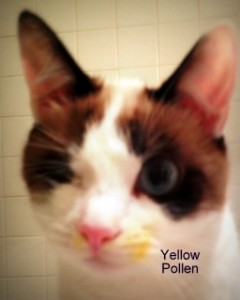
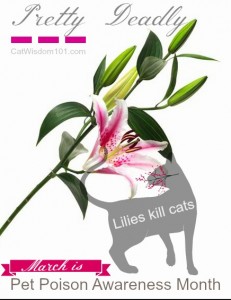
I was horrified! Lilies are extremely toxic to cats, causing kidney failure. The client found no evidence that Willie had eaten any part of the plant, but she didn’t know how long the pollen had been on his face or how much he might have ingested. I explained that even the pollen is extremely toxic to cats and that the best course of action was to bathe Willie and put him in the hospital on IV fluids immediately. She was reluctant to hospitalize him with no signs of illness, but did bathe him immediately.
The next day I heard from her again. Willie, normally into everything at all hours, wasn’t his normal, overactive self. He had also vomited and had diarrhea—another sign of lily poisoning. I told her to bring him in immediately!
When Willie arrived, he was behaving like a normal sedate cat—which was not at all normal for Willie. Ever since I removed a polyp from his throat about six months ago, he has been hard to keep still for even half a second. I was very worried. Willie’s physical exam revealed kidneys that were slightly swollen and painful.
Time for lab work. We drew urine and blood. After running the blood through our in-clinic analyzer, I knew things weren’t yet dire. Looking at Willie’s urine under the microscope, however, told me he wasn’t in the clear. I had seen casts in his urine. Casts are a protein coating of the urine-collecting tubules in the kidneys. We see them in urine samples only when non-urine materials are leaking into the tubules because of inflammation or other disease. Willie’s blood values had not yet changed, but it was still early. Most cats that start treatment for lily toxicosis within 24 hours of exposure will live. The survival rate goes down as time increases before starting therapy.
I hoped we had started treatment early enough, before the damage was too severe. We placed an IV catheter and started Willie on forced diuresis by giving him a balanced electrolyte solution at three times his normal usage rate. Willie didn’t much care for this. He kept telling us that he felt fine and really didn’t like having tape on his arm. We just kept telling him that he really did need the fluids and that he just had to stick it out for 48 hours.
At the end of the 48 hours, I looked at his urine again and ran his blood work again. No more casts! Yeah! His blood work, however, wasn’t quite so good. His creatinine level had risen to a point that is considered to be stage 2 kidney disease even though he had been on fluid therapy. The labs were good enough for Willie to go home and he was very happy that we finally listened to him about the tape on his arm. Further damage to his kidneys was unlikely, as the toxin appears to only be in the system for about 24 to 48 hours, but at least half of his kidney function was questionable.
At his recheck a week later, Willie was back to his normal, active self. His blood values are still not what they were before his adventure with the lily, but he is clinically normal. We are hopeful that his kidney function will return to normal over the next nine months. Most cats that make it through the initial acute kidney failure phase do regain kidney function. How much is regained is variable. Because Willie is an otherwise healthy young cat, he likely will regain most of his kidney function and not develop chronic kidney disease.
But no more lilies for Willie!
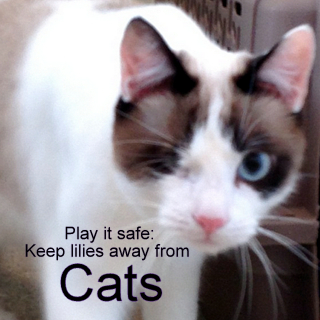
Please keep lilies out of houses that have cats. All plants in the lily family (Lilium and Hemerocallis genera) are toxic to cats. (Some plants that are called “lilies” are not in the lily family, but because several of these are toxic in their own way, one should, as a general rule, keep cats away from all plants named “lily.”) The mechanism of toxicity is unknown, but the poisoning is fast and deadly. For more information about lily toxicosis in cats, please see http://www.ncbi.nlm.nih.gov/pubmed/21147474, http://www.petpoisonhelpline.com/2011/09/are-lilies-poisonous-to-cats/, or, if you would like materials for your veterinarian’s office please see http://www.isfm.net/news/lilies/index.html



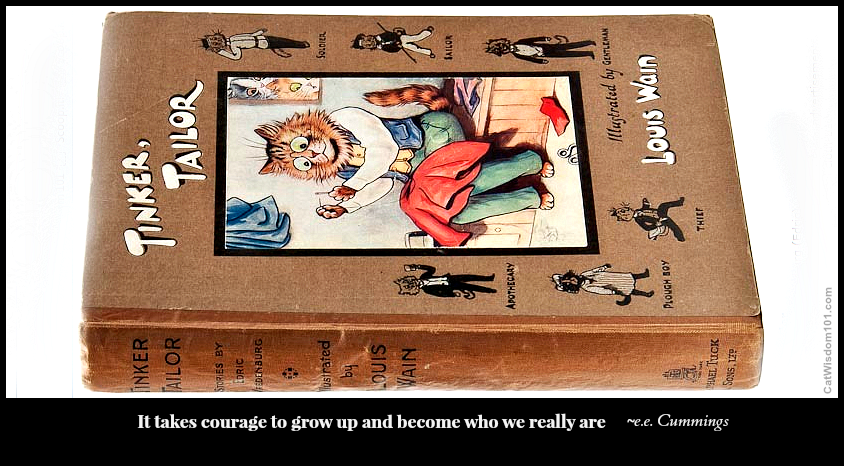
15 Comments
Pingback:
Skeeter and Izzy
It is always good to be reminded about the everyday things that can cause such terrible things to happen to our babies. Thank you guys for the reminder!!
Luvs
Skeeter and Izzy and the Feral Gang + Twig and Peanut and Romeo >^..^<
Angel AbbyGrace
The only flowers allowed in our house are silk ones!
Tamago
Great post. Lilies are such common flowers but very dangerous for kitties. I used to bring flowers home when my co-workers gift me for birthday, but not after Goro and Niko came to live with us. Have a happy and safe Easter 🙂
Brian
Yep, we’ve got none of those things here…unless they are silk!
Alana
We had a scare like that with Rocky! About 5 years ago or more. I have the same photo of him with the yellow all over his face. We took him in to the vet for emergency fluids and tests – he came through it fine, but those lilies were the most expensive bunch on the market at $500!
da tabbies o trout towne
doodz…a grate ree minder post….manee thanx…..N easter basket grass iz vizshuz az well…if it looks like string it mite bee played with N chewed…
heerz hopin everee one haza safe, happee N burd free Easturr ♥
easy rider
Oh poor Willie. But I’m glad he srvived this experience. I was puzzled as I read how much plants are bad for dogs and cats, even tulips are dangerous.
Layla Morgan Wilde
Thanks for reminding us about tulips. In fact are bulb type flowers are toxic to cats.
Fur Everywhere
Thank you for this very important reminder, Layla!
I am really nervous about having *any* flowers or plants in my house, except for cat grass. Any time I get flowers (non-toxic ones to the cats) I put them somewhere they cannot reach. I might be “overprotective” but I think it’s a good thing sometimes 🙂
nadbugs
Horrifying! The worst was that the kitty could be so threatened, yet the guardian was not persuaded. What ARE we to do with ourselves!! Typically, I go overboard and embargo ALL plants from this house, no matter what. Can’t be too careful, I say. And then disaster strikes from a completely unanticipated circumstance. Life. Not for the fainthearted. :/
Sparkle
I’ve known a couple of kitties on the internet who died of lily poisoning. My human loves lilies but will never have them in the house. She won’t even touch them. Thanks for this post – it explained, quite graphically, what lilies can do to a cat.
Anonymous
That was Kathryn.
Anonymous
Oh gosh, what a close call. I don’t keep flowers in the house at all and when someone sends me flowers, I remove lillies and babies breath and then check all the others. I keep the flowers in the sink and put wet sponges around the sink so that one of our two boyz, Mao, the Tux, can’t nibble without getting his feet wet. If that doesn’t work, I toss the flowers. I can always go to the store and look at flowers.
Ched doesn’t eat flowers, but Mao is the devil.
Layla Morgan Wilde
Good to know. It’s funny how some cats like to nibble and other don’t , even when they’re related. None of mine ever do, indoors or outdoors but I still check in case they change their mind!